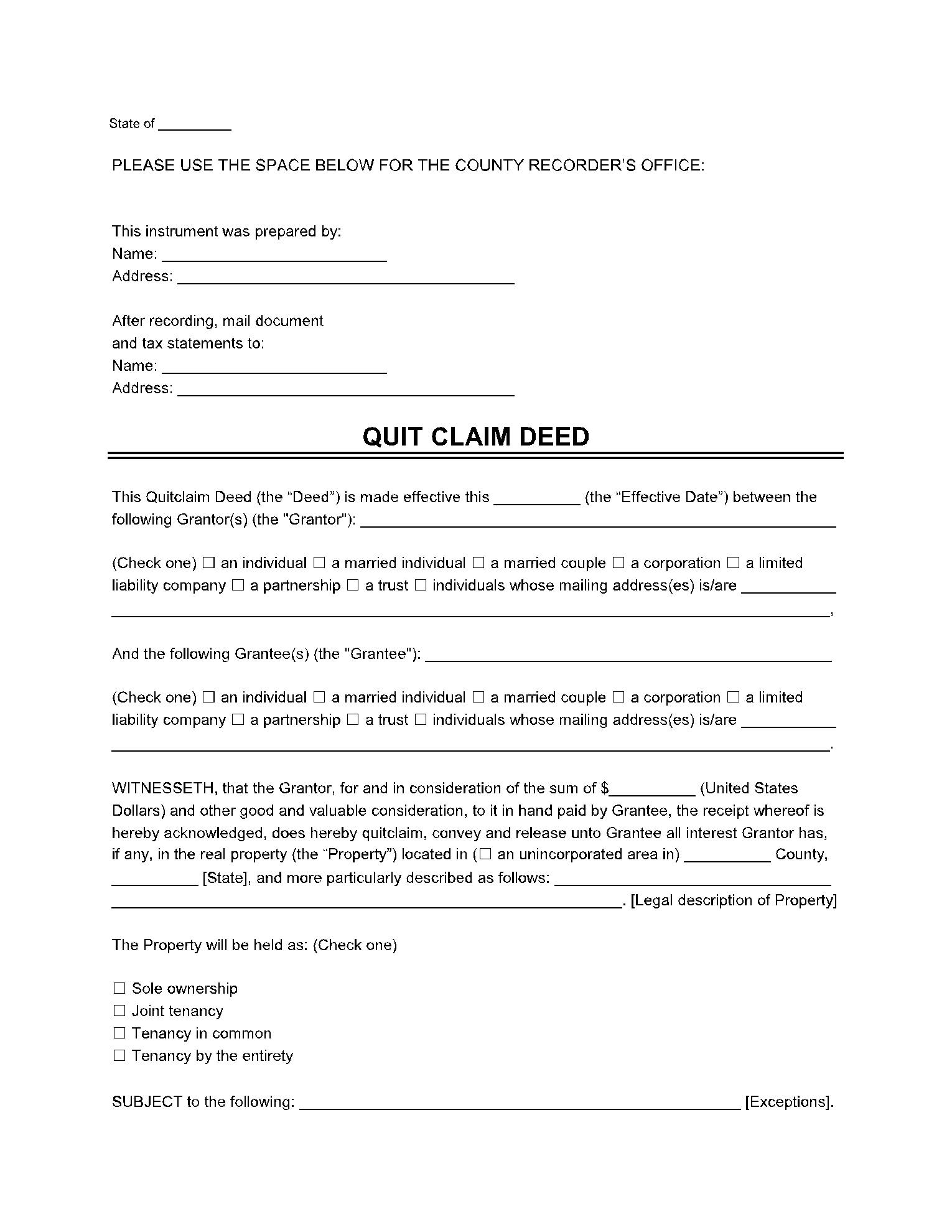Quitclaim deeds were not common in the United States until the mid-1800s, when property ownership started to mature after the revolutionary war. Prior to that, real property was transferred primarily via a process that involved warrants, surveys, and land patents.
In case you have discrepancies in the chain of title because it’s stolen, lost, or with inaccurate records, they could be cleared up by requesting a potential interest holder "quit" their claim to the land. You can create and download a free printable quit claim deed form at CocoDoc.
What Is a Quit Claim Deed Form?
A quitclaim deed form (or quitclaim) is a legal document used to transfer interests, ownership, or rights to the property from one party to another. The person giving away claim on the real estate is known as the grantor. The person receiving the property is called the grantee.
This legal form protects the grantee and prevents the grantor from returning and claiming an interest in the property after the quitclaim deed is finalized. Unlike other legal conveyance deeds, the quitclaim deed form conveys only the grantor’s interests at the time of the deed's execution. It does not guarantee that the grantor actually has full ownership of the property.
As a result of this risk, quitclaim deeds are usually only used when transferring property between two people who trust one another, such as family members or spouses. This lack of protection makes a quitclaim unsuitable when purchasing real property from an unknown party in a traditional sale.
Alternatively, a General Warranty Deed or Special/Limited Warranty Deed provides protections for the new owner. People mostly use Warranty Deeds in property sales to guarantee that the grantor has clear and complete interests in the property title without liens.
Common Uses of a Quit Claim Deed Form
Despite the risks involved with quit claim deed, this document is beneficial and practical in multiple ways. Quitclaim deeds are used for:
Transfers Between Family Members
- Quitclaims are often used to transfer property to and from family members, mostly used when parents grant a title to a child.
Adding or Removing A Spouse from Title
- Whether resulting from a divorce or a marriage, a property owner can use a quitclaim form to add a spouse to or remove a spouse from the property title.
Transferring Ownership to A Trust
- Family planning that deals with property meant to carry on through generations often involves an initial transfer from a family member into a trust
Removing A Cloud on Title for Title Insurance
- Title insurance companies find someone with potential interests in the property and ask him/her to waive those interests.
- Removing “clouds” in the title, such as fixing a misspelled name or other mistakes.
Transferring Legal Ownership to An LLC Or Corporation
- As withholding real property in protecting LLCs and Corporations is becoming more common, quitclaims are generally used to transfer ownership to those entities.
What to Include in a Quit Claim Deed Form?
Each County has specific formatting requirements for the recording of quitclaim deed forms. Here are the main elements:
- Title: The title of a legal document defines what type of document it is. In this case, the title is "Quitclaim Deed."
- Executed Date: This is the date that the legal document was completed, signed, and executed.
- Grantor: Include the name and mailing address of the individual(s) or corporation transferring their rights to the real estate to someone else
- Grantee: Include the name and mailing address of a person or entity receiving the ownership rights that are being transferred.
- Habendum: It’s the legal-speak that transfers the rights to the property.
- Consideration: It states what the Grantee gives to the Grantor in return for the property’s rights. How much, if anything, is being paid for the property.
- Legal Description: Details of the property being transferred is listed.
- Signatures: Both Grantor and grantee signature must be included in the quitclaim deed form. Grantor’s signatures usually must be notarized, and in some rare cases, separate witnesses must also witness the Grantor signing.
- Preparer: This section lets the world know who prepared the deed.
Benefits of Using a Quitclaim Deed Form
Dodging lengthy and hassling property transfer procedures through probate is one of the core benefits of quick deed property transfer. Others include:
- Simplicity in the process: Quick claim form for property transfer is perhaps one of the most straightforward known processes that require minimal paperwork and basic scratch expenses. In fact, you can use CocoDoc’s PDF editor and enjoy the ultimate convenience to fill, edit, sign, download, share and print your quit claim deed template.
- Tax advantages: Quit claim deed forms are exempt from tax, given that there is no money involved in transferring property rights from the owner to the heir. However, quick claim transfers do come under gift tax which is exempted to a limit of $1 million in a lifetime or 13,000$ per year before tax laws apply.
- Property dues do not get transferred with a quick claim: If the property is still under a mortgage or any other such obligations, this is your advantage. The recipient of the property is only entitled to usage of the premises but is not liable to pay the current dues and liens associated with it.
